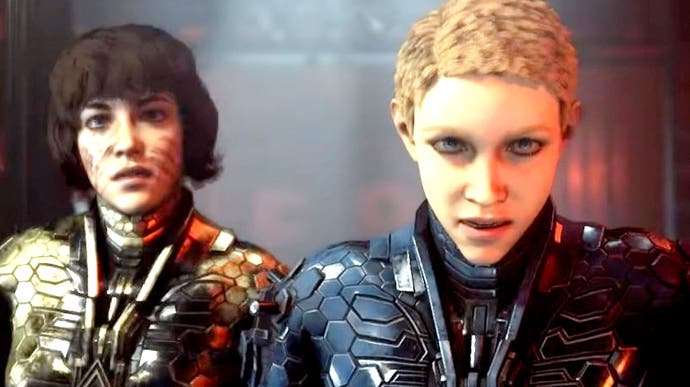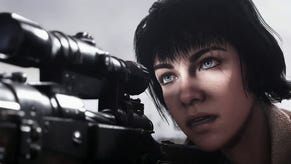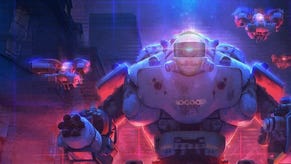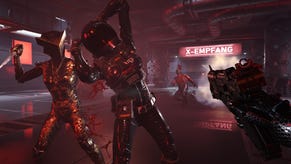Wolfenstein Youngblood gets ray tracing and VRS - is this an early preview of next-gen console features?
If so, the future's looking bright.
Hardware accelerated ray tracing, variable rate shading, advanced image reconstruction techniques driven by machine learning: these are all cutting edge rendering technologies likely to be a seriously big deal once the next generation console era is upon us. However, PC owners today have the ability to preview all of these technologies running in tandem in one of the most impressive and performant game engines around. Yes, Wolfenstein Youngblood has been patched to support the gamut of Nvidia RTX features and the results are highly impressive.
So what do users of RTX cards get with this new update to the latest and possibly last id Tech 6 title? Taking centre stage is ray tracing support, where the developers target one of the most challenging and expensive RT techniques: reflections. Much like Control or Battlefield 5, ray tracing replaces the game's use of cube maps and screen-space reflections on nearly every surface. In addition to increased realism, you also get the ability to 'see' reflections of the in-game world that don't exist in screen-space - like the player characters themselves, for example. However, the implementation is much wider ranging than you might imagine.
The embedded video on this page illustrates a couple of key aspects. First of all, you get to see how standard cube maps and screen-space reflections actually work - and then you get to see the more accurate ray traced alternative. It's quite fascinating how as players we've become accustomed to what are fundamentally compromised results. Game makers have got really good at 'faking' these effects and I also suspect that as virtually every major engine uses similar techniques, we've grown accustomed to their lack of realism. So when you sit down and study how those reflections should actually look, the results are eye-opening.Youngblood's effect is realistic right down to the most incidental details in the tiniest reflections.
Beyond adding in off-screen reflections or helping to fix lighting discontinuities from standard rasterised rendering techniques, ray traced reflections also represent material properties more realistically. In the standard id Tech 6, screen-space reflections only apply to very reflective objects: to maintain performance, the game engine stops SSR from applying to certain objects even though they should have them. Along with limiting screen-space reflections to ultra reflective surfaces, the standard version of the engine keeps those reflections uniformly sharp or diffuse depending on the surface. RT reflections apply more realistically to more surfaces: the reflection is sharpest at the point of contact, becoming more diffuse and darker as it continues on - as it should be.
The last big upgrade is in how transparent surfaces gain real-time RT reflections. Again, the video is the best place to be in seeing how transformative this is to the point where the player model can be seen reflected and distorted by the uneven surface, with changes in clarity according to the nature of the reflective material itself. My favourite moment with this effect concerned a dirty mirror where the clarity of the reflection changed depending on the dirty streak marks across the surface.
Overall, ray tracing delivers a really positive addition to the game's graphics but not everything is perfect. For example, I noticed how transparent reflections on water are still covered by standard rasterised screen-space reflections: ray tracing isn't used here and that's a shame. Also, occasionally, in some rare lighting conditions, the ray traced reflections seem to be overly bright which doesn't seem quite right. And lastly, sometimes you can see objects pop in and out of the ray traced reflections based upon the camera position, which looks a little awkward.
Generally though, the reflections look great, but of course, ray tracing hits the GPU hard in performance terms - to the tune of around 50 per cent. With that said, Youngblood still runs on RTX 2080 Ti at 4K resolution with ray tracing enabled with frame-rates mostly just a touch beneath 60fps - and that's with all other settings maxed. Upper mid-range GPUs like RTX 2060 Super run similarly, just at 1440p - though texture streaming needs to be cut back as 6GB of VRAM isn't enough to support RT and top-end textures.
However, that's nothing like the end of the story. There are further technologies in the mix that claw back performance with little hit to overall quality. Variable rate shading adds to the performance tally but with RT active, the boost only comes in at around four per cent across the length of the game's internal benchmark. That's still useful though, bringing RTX 2060 Super closer to a more stable 60fps. However, clearly it's not going to meaningfully offset the hit to performance brought about by the ray tracing technology.
The game has another trick up its sleeve, however. Deep-learning based image reconstruction is a game-changer for this game and Youngblood ships with three DLSS options: performance, balanced and quality. Pixel-counting this to get the base native rendering resolution is challenging but it seems that performance uses a 50 per cent resolution scale on each axis, balanced is closer to 57 per cent, while quality is 66 per cent. Regardless of the mode you choose, DLSS is impressive to the point where I believe you'd be nuts not to use it if the means are available to you.
The qualitative difference between native resolution and the various DLSS modes is ever so slight and in fact, there's a strong argument that in some scenarios, the DLSS image offers more clarity than native equivalents. Assuming a 4K output and DLSS performance mode set with an internal 1080p resolution, the image reconstruction mode is faster than using the game's internal scaler at 50 per cent - the same base resolution. This is possibly because the internal scaler still uses 4K post-processing. Regardless, seeing DLSS look as good as native 4K while outperforming the game set to upscale internally from 1080p is quite a feat.
As I see it, if you are running ray tracing in this game - and maybe even if you're not - there is no reason to run Wolfenstein Youngblood without using DLSS if you have an RTX card. The performance benefit is simply undeniable and with this in mind, the RTX 2060 Super can deliver ray traced visuals at 60 frames per second on the uber quality level.
This is a fascinating update overall that sets the pace for RTX implementations to come. Ray traced reflections are indeed expensive but the game has such a high performance baseline already that the performance hit relative to other implementations feels less impactful. We also learned some lessons here regarding what we might expect from the next generation of consoles. Here, VRS has a small positive effect on performance that isn't enough to offset the increased load from ray tracing - but is still appreciated nonetheless. However, it's DLSS that is the big surprise here: the quality is excellent and it demonstrates how developers may be able to balance expensive GPU effects with a decent quality output that still looks great on a 4K screen - exactly what the next-gen consoles will need. Assuming that those machines deliver GPU performance on par or better than RTX 2060 Super, I'd say that the future's looking bright... and yes, very shiny indeed.










